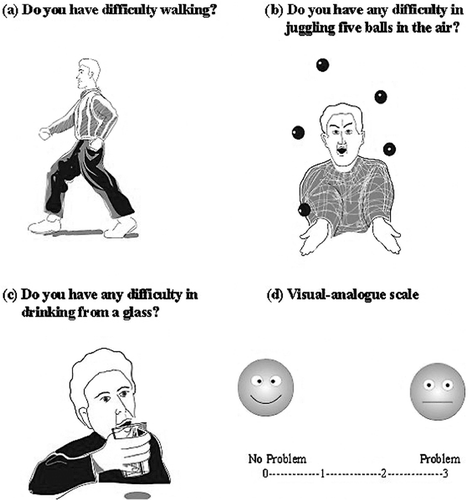Abstract
There has been a growing interest in anosognosia in both clinical and research domains, yet relatively little attention has been paid to methods for evaluating it. Usually, the presence and severity of anosognosia is assessed by means of structured interviews or questionnaires. Both interviews and questionnaires can provide valuable information, but they rely heavily on self-evaluation and language, and are therefore prone to bias and pose more difficulty in the assessment of aphasic patients. The aim of this study was to develop a new tool, the VATAm (Visual-Analogue Test for Anosognosia for motor impairment), to assess explicit anosognosia for motor impairments. The VATAm is a questionnaire that compares a patient's self-evaluation with a caregivers’ evaluation of the patient's abilities on a series of motor tasks. In addition, the test overcomes some of the limitations of the existing structured interviews and questionnaires, by enhancing reliability, improving data interpretation and diagnosis, and enabling assessment of patients with aphasia.
Keywords:
Introduction
Unawareness of one's own motor deficits is usually referred to as anosognosia for hemiplegia. It commonly occurs following brain damage, and patients may have anosognosia even when their motor deficits severely restrict daily life. Different theories have been proposed to account for anosognosia, but no theoretical interpretation appears to account for all of the different aspects of anosognosia that have been reported in the literature (see Vallar & Ronchi, Citation2006, and Vuilleumier, Citation2004, for recent reviews). There is now a growing consensus to consider anosognosia a heterogeneous syndrome, whereby varied signs and symptoms can be differently associated with different types of denial of motor deficits (Cocchini, Beschin, & Della Sala, Citation2002; Davies, Davies, & Coltheart, Citation2005; Marcel, Tegnér, & Nimmo-Smith, Citation2004; Vuilleumier, Citation2004). Despite the general consensus in considering anosognosia in these terms, the debate on anosognosia is complicated by diagnostic discrepancies (Orfei et al., Citation2007). As a result, it is difficult to compare findings from different studies (e.g., see Vallar & Ronchi's Citation2006 attempt to compare the neuroanatomy data from two studies).
The incidence of anosognosia varies considerably across different studies (see Jehkonen, Laihosalo, & Kettunen, Citation2006, and Orfei et al., Citation2007, for recent literature reviews). Baier and Karnath (Citation2005) suggested that high percentages of anosognosia might be “artificial” if the diagnostic criteria are too broad. However, studies reporting a low incidence of anosognosia (e.g., Baier & Karnath, Citation2005) may be criticized for the opposite reason, as they may have underestimated some forms of unawareness. For example, the frequency of anosognosia for motor impairment appeared to be higher when, rather than asking about their general condition, patients were asked to rate their ability in performing specific (bimanual) tasks (Cocchini, Beschin, Cameron, Fotopoulou, & Della Sala, in press; Marcel et al., Citation2004). Despite the crucial role of diagnostic instruments in assessing anosognosia, little attention has been paid to the methods of assessment and diagnostic tools. Indeed, several authors have acknowledged the need to identify new methods of assessment (Jehkonen et al., Citation2006; Orfei et al., Citation2007; Veuilleumier, Citation2004).
The most common method to explore explicit anosognosia (i.e., the patient's self-evaluation) is a structured interview, in which the patients are asked about their impairment (e.g., Ramachandran & Blakesee, Citation1998). While this method can be a valuable source of information, it mainly provides qualitative information about the patients’ views, and there is little consensus among authors about which symptoms should be considered evidence of unawareness (Baier & Karnath, Citation2005).
In more systematic assessments, patients are required to rate their ability (or difficulty) in performing specific tasks using their upper or lower limbs, such as clapping or walking (e.g., Berti, Làdavas, & Della Corte, Citation1996; Marcel et al., Citation2004). Such methods provide a quantitative evaluation of the patient's awareness for upper and lower limbs, and allow clinicians and researchers to identify possible changes in self-awareness across time. However, without normative data to guide interpretation, it can be difficult to identify mild forms of anosognosia. Therefore, the use of these tools is generally limited to patients who have complete paresis, and it leads to a dichotomous diagnosis, since the lack of norms does not give a clear indication of intermediate values. Moreover, despite previous attempts (e.g., Marcel et al., Citation2004), no systematic procedure has been identified to control for the patients’ compliance.
The issue of reliability is also important as anosognosia has been linked with other cognitive impairments (e.g., Levine, Calvanio, & Rinn, Citation1991), including frontal syndromes (e.g., Berti et al., Citation2005), which may bias patients’ responses.
Finally, the rating tests that are available rely heavily on verbal competence, which often leads to the exclusion of aphasic patients (e.g., Stone, Halligan, & Greenwood, Citation1993; see also Cocchini et al., in press, for comparison of different methods of assessment).
The aim of this study was to develop a new tool to diagnose explicit anosognosia. The proposed tool consists of a simple questionnaire that: (1) allows comparison of the patient's score with norms for diagnosis and identifies degrees of awareness for different degrees of motor impairment; (2) enables selective assessment of anosognosia for both upper and lower limb motor impairment; (3) is very reliable; (4) is easy and quick to administer; and (5) is suitable for assessment of patients with language deficits.
Method and Materials
Visual-Analogue Test for Anosognosia for motor impairment (VATAm)
Pilot study
A series of 17 pictures were presented to a group of five healthy volunteers who were recruited from members of staff. The pictures illustrated simple motor tasks (e.g., jumping, walking, clapping, waving etc.). The volunteers were asked to name the motor tasks that were depicted. If the motor task was not correctly or clearly identified by at least four out of five participants, the picture was amended in accordance with the volunteers’ feedback. The amended versions of the pictures were presented to a new group of five healthy volunteers and to three aphasic patients who had motor impairment. They all correctly identified all the items. The people with aphasia were also asked to rate their motor difficulties on a 4-point visual-analogue scale. A score of 0 indicated “no difficulty in carrying out the task,” and a score of 3 indicated “major difficulties or impossibility in carrying out the task.” Scores between 0 and 3 were displayed along the scale, with written labels “no problem” and “problems” at the extremities, together with a smiling or non-smiling face to aid comprehension (see later). The patients could respond verbally (e.g., rating “3” or “Problem”) or non-verbally (i.e., pointing to the scale). The three patients had no difficulty in using this rating scale.
Participants
A total of 68 stroke patients, 33 with left-brain damage (LBD) and 35 with right-brain damage (RBD) were included in the study (see for demographic details). All patients had unilateral vascular lesions demonstrated by CT scan. None had previous psychiatric problems. Most of the patients had weekly rehabilitation for their motor deficits. Demographic and clinical features are summarized in . Age and years of formal education did not differ significantly between the two groups (F = 1.4; ns, and F < 1; ns, respectively), but the time between onset and assessment was significantly different (p <. 05).
Table 1 Demographical and clinical features of RBD and LBD patients entering the study
All patients showed some degree of motor impairment in at least one limb (i.e., score of at least 1, see below) on the Standard Neurological Examination for upper and lower limbs (Bisiach, Vallar, Perani, Papagno, & Berti, Citation1986). In this test the score for each limb ranged from 0 (normal motor performance) to 3 (complete paresis). Scores of 1 and 2 were given for mild and moderate motor impairment, respectively. Poor performance on this test due to apraxia, tremor, or ataxia was not considered to be evidence of paresis. Motor impairment of both upper and lower limbs was not significantly different across LBD and RBD patient groups (p =. 09 and p =. 07, respectively).
All patients were asked to rate their motor deficits using the VATAm (see below). A group of 100 healthy volunteers who were caregivers (average age = 46.88; SD = 15.30; range = 27–78) also participated in the study. They were asked to rate the patients’ motor difficulty using the VATAm. In some cases, more than one caregiver was recruited to rate the same patient's motor impairment. The caregivers met the patients on a regular basis (daily or weekly) for professional (i.e., therapists, nurses, etc.) or personal (i.e., partners, family members or close friends) reasons.
None of the volunteers who participated in the pilot studies were included in the experimental phase. All patients and caregivers gave written informed consent prior to participation in the study.
VATAm
The VATAm comprises 1 example and 16 questions with an illustration to depict each question. The illustrations facilitated comprehension of the questions for people with aphasia. The 4-point visual-analogue scale (see ), which had previously been piloted, was used for each item. The test consists of 1 example and 12 questions about the patients’ ability to perform tasks that require the use of both hands (8 questions) or both feet (4 questions; “bilateral tasks”, e.g., walking, see ). Four questions that elicit obvious answers (“check questions”, e.g., “Do you have any difficulty in jumping over a lorry?”; see Appendix) were used to monitor poor compliance, comprehension problems, and perseveration. For two check questions the expected responses were 0 or 1 (e.g., “Do you have any difficulty in drinking from a glass?”; see ) and for the other two the expected responses were 2 or 3 (e.g., “Do you have any difficulty in juggling five balls in the air?”; see ). Two of these check questions related to tasks for upper limbs and two related to lower limb tasks. The check questions were not included in the final scoring for anosognosia. They were used to monitor the participant's compliance with the task. Participants who did not provide the expected answers to all check questions were excluded from the final analyses.
Test items were presented in a fixed random order. Each picture was displayed on an A4 sheet and was placed on the patient's ipsilesional side to minimize the effect of possible unilateral visuo-spatial disorders. The examiner read aloud the whole question or just the core action (e.g., “washing hands?”).
The final version of VATAm is described in the Appendix, and is also available on the following web page: http://homepages.gold.ac.uk/gcocchini
VATAm total score
Each of the 12 questions received a score from 0 (no problem) to 3 (problem). The total VATAm score was calculated by adding the scores from the 12 questions, giving a range from 0 to 36. The patient's total rating was then subtracted from that of their caregivers who rated the patient's motor skills (caregiver–patient discrepancy). Whenever possible, two caregivers were asked to provide a rating for the same patient (a relative and a member of staff). In these cases, the patient's rating was compared with the average of the caregivers’ scores. The caregiver–patient discrepancy value ranged from–36 to +36. A value of zero indicated a perfect agreement between caregiver/s and patient; a positive value indicated that the patients overestimated their motor abilities (i.e., anosognosia); a negative value indicated that the patients underestimated their motor abilities in comparison with the caregivers’ evaluations.
VATAm limb scores
The VATAm score for the upper limb movement was based on eight questions. The score ranged from 0 to 24 and the caregiver–patient discrepancy value (as described above) ranged from −24 to +24.
The VATAm score for the lower limb movement was based on four questions. The score ranged from 0 to 12 and the caregiver–patient discrepancy value ranged from −12 to +12.
For both upper and lower limb VATAm scores, positive and negative values suggested that the patients overestimated or underestimated their upper/lower limb motor abilities, respectively. A value equal to zero indicated a perfect agreement.
Sensory-motor impairment
Motor skills were further examined by a physiotherapist (who did not act as caregiver for the VATAm rating) using the Motricity Index (Wade, Citation1992) in a subgroup of 54 patients. The patients sat in a chair or a wheelchair. Six limb movements of contralesional upper and lower limbs were assessed: “pinch grip,” “elbow flexion,” “shoulder abduction” (for upper limb), “ankle dorsiflexion,” “knee extension,” “hip flexion” (for lower limb). In accordance with the published scoring instructions (Wade, Citation1992) for each of these movements, a score from 0 (no movement) to 33 (normal power) was given. Each score for limb movement was then calculated by adding the score for the related three movements plus 1, to give a score between 1 (severe impairment) and 100 (normal power) for each limb. The average between the upper and lower limb scores gave a total score (from 1 to 100) also known as “side score.” The Motricity Index has high validity and reliability for both upper and lower limbs (see, e.g., Bohannon, Citation1999; Cameron & Bohannon, Citation2000).
Results
Assessment of awareness (VATAm)
Check questions
Three LBD and two RBD patients responded incorrectly to at least one check question, so their data (and that of their caregivers) were not included in the final analyses. Data from one caregiver were also excluded from the final analyses as he incorrectly rated two check questions. In this case, the patient's rating was compared with that of the other available caregiver.
Unawareness cut-off scores and degrees of severity
The above participants were excluded and the responses of 63 patients (30 LBD and 33 RBD) and 99 caregivers were included in the final analyses. For 36 patients there were ratings by two caregivers: one with a personal relationship (e.g., friend or relative), and one with a professional relationship (e.g., therapist, doctor, nurse, psychologist). The rating difference between personal (mean = 28.5; SD = 5.5) and professional caregiver (mean = 27.6; SD = 7.1) was not significant. These data are in line with previous studies showing that the ability to rate cognitive competence is not dependent on factors such as personal relationship (Smith, Della Sala, & Logie, Citation2000). The Motricity Index (a high score relates to better performance) of 54 patients was compared with their caregivers’ VATAm ratings (low score relates to better performance). A Pearson correlation showed a highly significant negative correlation (r = −.47; p <. 01, two-tailed), which accounted for about a fourth of the total variability. This suggests that the caregivers’ ratings were a reliable measure of the patients’ motor impairment, and also that their ratings reflected the impact of the motor deficit on everyday tasks.
The VATAm ratings of the 36 pairs of caregivers judging the same patient were compared to give the “discrepancy threshold.” A caregiver–patient discrepancy value below the discrepancy threshold should not be considered as a sign of pathological unawareness (see below).
VATAm total score
The total rating score by each caregiver evaluating the same patient was compared to give a caregiver's discrepancy score. This score ranged from 0 (i.e., perfect agreement) to 36 (i.e., complete disagreement). The difference between the two caregivers’ scores was then calculated to give a group mean discrepancy of 1.9 (SD = 2.2). A value equivalent to two standard deviations above the group mean (i.e., +6.3) was taken as a cut-off score. Assuming a normal distribution, then two standard deviations encompass over 95% of the data points. This stringent cut-off point was chosen to allow specificity in favor of sensitivity, following the normal practice in several neuropsychological studies (see discussions in, e.g., Capitani & Laiacona, Citation1997; Crawford & Howell, Citation1998; Heaton et al., Citation2001; Hinton-Bayre, Citation2004). A caregiver–patient discrepancy above this value was considered to be an indication of anosognosia. A value equivalent to two standard deviations below the group mean (i.e., −6.3) was considered to be a pathological underestimation of own motor abilities (which may have been due to depression; e.g., Starkstein & Robinson, Citation1993).
Two further cut-off scores were considered in order to evaluate different degrees of unawareness. The first cut-off point was 12, as this assumed an average discrepancy of 1 rating point across all the 12 questions. Discrepancy scores between 6.3 and 12 were considered to be an indication of mild anosognosia. The other cut-off point was 24—this assumed an average discrepancy of 2 rating points across all 12 questions. Discrepancy scores between 12.1 and 24 were considered to indicate moderate anosognosia. Discrepancy scores between 24.1 and the maximum possible discrepancy value (i.e., 36) were considered to indicate severe anosognosia (see ).Footnote1
Table 2 Degree of severity of unawareness as defined by the discrepancy scores (see text)
VATAm limb scores
Cut-off scores for upper and lower limb movement were calculated following the same procedure described above. The discrepancy values were based on the ratings of the 36 pairs of caregivers who rated the same patients’ motor impairment. The mean discrepancy was 1.4 (SD = 1.2) for upper limb movement and.7 (SD = 1.4) for lower limb movement. Following the same procedure described above, the following cut-off points and score bands were identified: 0–3.7, 3.8–8, 8.1–16, and 16.1–24 for the upper limb sub-test, and 0–3.4, 3.5–4, 4.1–8, and 8.1–12 for the lower limb subtest. The classification of the different degrees of awareness according to these scores is shown in .
Test–retest reliability
A total of 63 caregivers and 49 patients were retested on a separate occasion (between 24 hours and 3 days later). Separated Spearman-Brown correlation analyses were carried out for caregivers and patients. Both groups showed very high correlation coefficients, i.e., r =. 95 (p <. 01) and r =. 83 (p <. 01) for caregivers and patients, respectively.
Analyses of patients’ awareness
Out of 63 patients, 26 (i.e., 41%) showed different degrees of unawareness (i.e., a caregiver–patient discrepancy score above the unawareness cut-off score of 6.3). Of these 26 patients, 12 were LBD (40% of all LBD patients) and 14 were RBD (42% of all RBD patients). They were tested on average 93.8 (SD = 42.1) and 64.9 (SD = 42.3) days respectively following brain damage. A total of 19 patients showed moderate (15) or severe (4) anosognosia. They were all tested during the chronic or post-acute phases (i.e., from 50 to 90 days). Anosognosia for limb motor impairment was evaluated and 41% (i.e., 26 out of 63) patients (47% with LBD and 39% with RBD) showed unawareness of upper limb deficits, while 33% (21 out of 63) patients (37% with LBD and 27% with RBD) showed unawareness of lower limb impairment (see ).
Table 3 Number (and percentages) of RBD (total = 33) and LBD (total = 30) patients who were aware or showed some degree of unawaress for the motor deficits of their upper or lower limb
A total of 14 patients, who had motor impairment of both limbs with ranging levels of severity, showed lack of awareness only of the upper limb (10 patients) or of the lower limb (4 patients) (see ). Of these patients, 9 (patients 36, 44, 53, 13, 42, 11, 59, 27, and 52) presented with the same degree of motor impairment of both limbs.
Table 4 Individual patients who showed a dissociation between awareness for upper and lower motor impairment
Four patients (three with LBD and one with RBD) underestimated their motor abilities (i.e., a discrepancy score higher than −6.3). This was not the focus of this study, so was not investigated further.
Internal consistency and sensitivity
Internal consistency was analyzed separately for upper- and lower-limb questions. Discrepancy values were calculated for each question and each patient using Cronbach's alpha test. The internal consistency was high for both groups of questions (Cronbach's alpha =. 929 and. 840 for upper and lower limb questions, respectively).
A further analysis was carried out in order to identify those questions that were more sensitive to unawareness, i.e., questions that gave a positive discrepancy only when the patient was deemed to be unaware. A total of 26 patients were classified as “unaware” according to the total VATAm score (these included the three different degrees of unawareness) and 37 were classified as “aware.” Caregiver–patient discrepancy scores were analyzed for each of the 12 questions. The number of patients who were unaware and had a positive discrepancy (i.e., scores 1 to 3; Hits) and the number of those who did not have a positive discrepancy (i.e., scores from −3 to 0; Correctly Not Detected, CND) were calculated. Percentages of Hits and CND for each question are shown in . The percentage of patients who were correctly classified by each question averaged over 80% (range 73.0 to 90.5). Similar analyses were carried out separately to evaluate the questions for upper and lower limbs, and to identify which patients were aware or unaware according to the VATAm limb scores. The average percentages of patients who were correctly classified by each “upper-limb question” and each “lower-limb question” were 84.5% and 85.7%, respectively (see ). The three most sensitive questions for upper limb movement were “opening a bottle,” “washing dishes,” and “dealing a pack of cards,” whereas for lower limb the most sensitive questions were “jumping,” “climbing the stairs,” and “riding a bicycle.”
Table 5 Percentage of patients correctly classified as unaware (Hits) and correctly classfied as aware (CND) for each question
Interestingly, “clapping hands” and “walking” were relatively poor predictors of unawareness in comparison with other questions in the VATAm, but questions about these motor tasks are often used in structured interviews for anosognosia (e.g., Ramachandran & Blakesee, Citation1998).
Awareness for motor deficits and degree of motor impairment
Motor impairment was evaluated in a subgroup of 54 patients (33 RBD and 21 LBD) using the Motricity Index test (Wade, Citation1992). RBD patients had milder motor impairment (mean = 39.5; SD = 22.2) than LBD patients (mean = 28.8; SD = 26.5), and anosognosic patients (14 RBD and 8 LBD) showed milder motor impairment (mean = 42.7; SD = 23.7) than patients who were aware of their deficits (19 RBD and 13 LBD) (mean = 30.3; SD = 23.7). The motor index data (see for details) were analyzed using a two-way ANOVA (side of lesion versus awareness). The analysis showed a significant effect of lesion side, F(1, 50) = 4.2; p <. 05, and a significant interaction between the two factors, F(1, 50) = 5.2; p <. 05. A post-hoc analysis (using Bonferroni's correction) showed that anosognosic patients with RBD were significantly (p <. 05) less impaired than RBD patients who were aware of their deficits and significantly less impaired (p <. 05) than patients with LBD who had anosognosia.
Figure 2 Motricity index scores for LBD and RBD patients who were aware or unaware of their impairment according to VATAm: (a) Group of 54 patients, (b) Group of 34 patients matched for motor impairment.
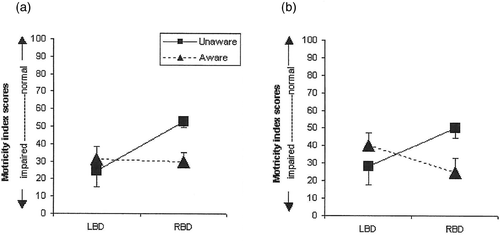
This difference in motor impairment between RBD and LBD patients was analyzed further in a subgroup of RBD and LBD patients. They were matched according to the level of their motor impairment. Eight LBD patients had very severe motor impairment (motor index = 1) in comparison with only four RBD patients. Therefore the four LBD patients who were tested first were matched with the four RBD patients who presented with the same degree of motor impairment. The resulting matched subgroups consisted of 17 RBD and 17 LBD patients. The average motor impairment scores for RBD and LBD patients were 35.29 (SD = 25.08) and 35.32 (SD = 25.27), respectively (see for details). Within each subgroup, 7 patients (41.2%) showed anosognosia and 10 were aware of their deficits, so the frequency of anosognosia was the same across both subgroups. The level of unawareness (i.e., VATAm discrepancy score) was 6.00 (SD = 8.58) for the RBD and 8.00 (SD = 14.11) for the LBD sample. This difference was not significant.
The data from the patients with RBD showed a significant positive correlation (r =.50, p >.05, two-tailed) between the degree of motor impairment and the level of unawareness. This suggested that the milder the motor impairment, the more likely RBD patients were to show anosognosia. On the contrary, the data from the patients with LBD showed a negative correlation (r = −.23, p =. 36) between level of unawareness and degree of motor impairment, which was not significant, however.
A similar trend was seen in the degree of motor impairment. Patients with RBD who were aware had more severe motor impairment (mean = 24.90; SD = 26.10) than those who were unaware (mean = 50.14; SD = 14.77). In contrast, patients with LBD who were aware had a milder motor impairment (mean = 40.15; SD = 22.75) than those who were unaware (mean = 28.43; SD = 28.85). Motor index data were analyzed using a two-way (side of lesion versus awareness) ANOVA (see ). The analysis showed a significant interaction between these two factors, F(1, 30) = 4.9; p <. 05. A post-hoc analysis (using Bonferroni's correction) showed that patients with RBD who had anosognosia were significantly less impaired (p <. 05) than patients with RBD who were aware of their deficits.
Discussion
The VATAm
The first aim of this study was to devise a test to assess anosognosia for motor impairment that would overcome some of the limitations of existing diagnostic tools. The new assessment aimed to provide normative data in order to make a diagnosis of anosognosia and to be sensitive enough to highlight moderate and mild motor disorders.
The VATAm is able to establish the level of awareness by comparing patients’ and caregivers’ ratings of the patients’ motor difficulties. Analyses showed that caregivers’ ratings appeared to correlate with assessment of motor impairment using the Motricity Index. The VATAm can be used with patients who present with different degrees of motor impairment, not just those with complete paresis, as is mostly the case with structured interviews (e.g., Ramachandran & Blakesee, Citation1998). The VATAm provides normative data to evaluate caregiver–patient discrepancy and to establish the level of severity. The comparison with normative data is a crucial issue as the risk of false alarms is a serious concern (Baier & Karnath, Citation2005), especially in the evaluation of different degrees of unawareness. The VATAm is the first assessment that provides a scoring system and cut-off points to minimize this risk. The level of awareness/unawareness was shown to depend on the degree of motor impairment. The milder the motor impairment, the lower the possible caregiver–patient discrepancy, and consequently the lower the level of anosognosia. For example, a patient who is completely unaware of his mild motor disorder (e.g., caregiver's total rating = 10) would not be diagnosed as severe anosognosic, as the discrepancy score cannot exceed the caregiver's total rating. In this example, the discrepancy score would fall within the “mild anosognosia” range.
The second aim of this study was to devise a test that would selectively evaluate and interpret awareness of upper and lower limb movement. Previous studies (e.g., Berti et al., Citation1996) have demonstrated that awareness of upper and lower limb impairment may differ, and this may result, in some cases, in a selective anosognosia for one limb impairment only. The VATAm test allows separate evaluation of upper and lower limb movement.
The third aim was to ensure that the test was reliable. Brain-damaged patients often present with a variety of cognitive impairments that may affect specific assessments and bias the results, especially in acute phase when patient may present with a confusional status. In accordance with other tools (Marcel et al., Citation2004), the VATAm incorporates four mono-manual and mono-pedal questions to highlight possible confounding variables such as lack of comprehension of the task instructions, lack of compliance, poor attention, and perseveration. This allows inclusion of any patient even if in the acute phase, in view of a possible exclusion a posteriori. Indeed, 7% of the initial patient group and 1% of the caregivers were excluded, as their responses were unreliable. The VATAm was found to be reliable, with a high correlation between test and retest. The “monitoring system” and the high test–retest correlation together suggest that the data gathered from the 93% of patients and 99% of caregivers were reliable.
The VATAm is suitable for follow-up assessments as it allows comparisons across testing sessions, and the caregivers’ ratings vary according to the patients’ motor improvement, if any. Moreover, the VATAm investigates awareness across 12 different tasks, and the internal consistency was very high for both upper and lower limb questions. Each question predicted the final VATAm score with high accuracy and three questions for each limb subtest correctly predicted the final VATAm in over 85% of the cases. This suggests that even short versions of the VATAm could be considered with a relatively low chance of error. This meets the fourth aim of the study, which was to devise a quick and easy test also reliable for retesting.
Finally, the VATAm is particularly suitable for assessing the presence of anosognosia for motor impairment in aphasic patients as it includes pictures to illustrate each question, and a visual-analogue scale to facilitate verbal and non-verbal responses. Most aphasic patients were able to complete the questionnaire and provide reliable data. Only 9% of the LBD patients had to be excluded. This is a considerable achievement as aphasic patients are usually excluded from anosognosia assessment (Cutting, Citation1978; see also Cocchini et al., in press, for detailed analyses of this issue).
Novel findings
Some other interesting results have emerged from the study. The literature suggests that about half of the RBD patients in the acute stage show some degree of anosognosia for motor impairment (e.g., Cutting Citation1978; Feinberg, Roane, Kwan, Schindler, & Haber, Citation1994; Karnath, Baier & Nagele, Citation2005; Nathanson, Bergman, & Gordon, Citation1952; Starkstein, Fedoroff, Price, Leiguarda, & Robinson, Citation1992; Stone et al., Citation1993; see also Jehkonen et al., Citation2006, and Orfei et al., Citation2007, for recent reviews). In the current study, 41% of the total group of brain-damaged patients showed some degree of unawareness. The experimental group consisted mainly of patients in the sub-acute and chronic phases. This suggests that lack of awareness for motor impairment may be frequent even in less acute phases. This contrast with the literature may be accounted for by the different methods used to assess unawareness. Anosognosia is usually assessed using structured interviews, in which patients are asked about the reason for being hospitalized, and about their difficulties. However, this type of assessment may not be suitable for sub-acute and chronic patients who have received direct or indirect information about their motor impairment during their rehabilitation. Levine et al. (Citation1991) highlighted that only patients with major cognitive impairment would not be able to respond correctly to these general questions. Therefore, the use of open questions may have masked the presence of anosognosia in more chronic phases. Interestingly, Marcel et al. (Citation2004) found that about 29% of a group of sub-acute and chronic RBD patients were unaware of their motor deficits when interviewed about general difficulties, but a much higher percentage considerably underestimated their motor disorder when they were questioned about specific tasks.
On the other hand, Baier and Karnath (Citation2005) have highlighted the risk of “artificial high percentage of anosognosia” (p. 359) resulting from potential false positives. We concur, but we also consider that it is important to reduce the risk of false negatives, which can lead to an underestimation of the syndrome. We found that only 6% of patients in our study showed severe anosognosia, whereas 35% showed different degrees of unawareness, from mild to moderate.
Despite the fact that other methods may be preferred for qualitative evaluations, the VATAm is a sensitive tool which enables the examiner to assess different degrees of anosognosia, and is particularly appropriate for patients in sub-acute and chronic phases. Our data are in line with the few studies in the literature that show that anosognosia may decline with time, but is far from being solely a transient phenomenon (see review in Cocchini et al., Citation2002, ).
A second finding emerged from the performance of LBD patients. These patients have rarely been included in large group studies on anosognosia and when they were, the studies had a high rate of exclusion due to aphasia (e.g., Cutting, Citation1978). This high exclusion rate may have masked the actual incidence of unawareness in these patients (Nathason et al., Citation1952). In our study, very few aphasic patients were excluded and 40% of the LBD patients showed some evidence of unawareness. Interestingly, only 10% of them showed mild anosognosia, whereas the remaining 30% showed moderate or severe anosognosia. These figures are comparable with those of the RBD group, which suggests that the two groups not only have a similar frequency, but also a similar degree of severity of unawareness. Cocchini et al. (in press) have investigated the frequency of anosognosia following left-brain damage by comparing the outcome of the VATAm with that of structured interviews. In accordance with the literature, the authors found a relatively low percentage of aphasic patients who had anosognosia when they were assessed with the structured interviews, but the percentage increased considerably when the VATAm was used. The authors concluded that a possible combination of a low exclusion rate together with a more sensitive method to assess unawareness in the sub-acute and chronic phases could account for a higher frequency of LBD patients with anosognosia than anticipated.
Double dissociations between awareness of upper and lower limb motor impairment have been reported in the literature (e.g., Berti et al., Citation1996; Bisiach et al., Citation1986). We identified 14 patients with motor disorders of both limbs who showed this type of dissociation. It is also interesting to note that this double dissociation was observed in both LBD (six cases) and RBD (eight cases) patients. In both LBD and RBD groups we found a higher frequency of unawareness for motor deficits of the upper limb (47% and 39%, respectively) in comparison with those of the lower limb (37% and 27%, respectively).
Finally, within the RBD group alone, anosognosic patients had milder motor disorders than patients who were aware of their deficits. The RBD patients’ data appear in line with Levine's (Citation1990; Levine et al., Citation1991) discovery theory, which suggests that the milder the motor deficit, the more difficult it is to discover it by self-observation. Anosognosia following RBD may be mainly caused by a difficulty in detecting an existing impairment, for example associated personal neglect. However, LBD patients’ results showed no clear relationship between the level of unawareness and the severity of the motor deficit. This supports the recent hypothesis that anosognosia is not a unitary syndrome, but a multi-factorial phenomenon (Cocchini et al., Citation2002; Davies et al., Citation2005; Marcel et al., Citation2004; Orfei et al., Citation2007; Vuilleumier, Citation2004). Therefore, anosognosia following LBD may be due to causes different than those eliciting anosognosia in RBD patients.
Acknowledgments
This research was supported by the Stroke Association (grant n. TSA 06/02) and partly by a Wellcome Trust grant (grant n.078580). We would like to thank Prof. Bono, Dr. Girardi, Dr. Zaro, and Dr. Hamilton for their support in recruiting the patients in Italian (Reparto di Neurologia–Ospedale di Varese; Reparto di Riabilitazione–Ospedale di Gallarate) and Scottish (Woodend Hospital in Aberdeen) wards. We are also grateful to the Medical Illustrations Department, University of Aberdeen for designing the illustrations for the VATAm.
Notes
1 Note that the degree of unawareness strictly depends on the degree of motor impairment. For example, a patient with mild motor impairment would receive quite a low score from the caregiver (e.g., 10). If the patient is completely unaware of this mild motor disorder, the discrepancy score would be no higher than 10, i.e., into the range of mild unawareness. According to this analysis, unawareness of a mild deficit would never indicate a severe pathological phenomenon.
References
- Baier , B and Karnath , HO . 2005 . Incidence and diagnosis of anosognosia for hemiparesis revised . Journal of Neurology, Neurosurgery, and Psychiatry , 76 : 358 – 361 .
- Berti , A , Làdavas , E and Della Corte , M . 1996 . Anosognosia for hemiplegia, neglect dyslexia and drawing neglect: Clinical findings and theoretical considerations . Journal of International Neuropsychological Society , 2 : 426 – 440 .
- Berti , A , Bottini , G , Gandola , M , Pia , L , Smania , N Stracciari , A . 2005 . Shared cortical anatomy for motor awareness and motor control . Science , 309 : 488 – 491 .
- Bisiach , E , Vallar , G , Perani , D , Papagno , C and Berti , A . 1986 . Unawareness of disease following lesions of the right hemisphere: Anosognosia for hemiplegia and anosognosia for hemianopia . Neuropsychologia , 24 : 471 – 482 .
- Bohannon , RW . 1999 . Motricity Index scores are valid indicators of paretic upper extremity strength following stroke . Journal of Physical Therapy Science , 11 : 59 – 61 .
- Cameron , D and Bohannon , RW . 2000 . Criterion validity of lower extremity Motricity Index scores . Clinical Rehabilitation , 14 : 208 – 211 .
- Capitani , E and Laiacona , M . 1997 . Composite neuropsychological batteries and demographic correction: Standardization based on equivalent scores, with a review of published data . Journal of Clinical Experimental Neuropsychology , 19 : 795 – 809 .
- Cocchini , G , Beschin , N and Della Sala , S . 2002 . Chronic anosognosia: A case report and theoretical account . Neuropsychologia , 40 : 2030 – 2038 .
- Cocchini , G , Beschin , N , Cameron , A , Fotopoulou , A and Della Sala , S . Anosognosia for motor impairment following left-brain damage. . Neuropsychology , (in press).
- Crawford , JR and Howell , DC . 1998 . Comparing an individual's test score against norms derived from small samples . The Clinical Neuropsychologist , 12 : 482 – 486 .
- Cutting , J . 1978 . Study of anosognosia . Journal of Neurology, Neurosurgery, and Psychiatry , 41 : 548 – 555 .
- Davies , MD , Davies , AA and Coltheart , M . 2005 . Anosognosia and the two-factor theory of delusions . Mind & Language , 20 : 209 – 236 .
- Feinberg , TE , Roane , D , Kwan , PC , Schindler , RJ and Haber , LD . 1994 . Anosognosia and visuoverbal confabulation . Archives of Neurology , 51 : 468 – 473 .
- Heaton , RK , Temkin , N , Dikmen , S , Avitable , N , Taylor , MJ Marcotte , TD . 2001 . Detecting change: A comparison of three neuropsychological methods, using normal and clinical samples . Archives of Clinical Neuropsychology , 16 : 75 – 91 .
- Hinton-Bayre , AD . 2004 . Holding out for a reliable change from confusion to a solution: A comment on Maassen's “The standard error in the Jacobson and Truax Reliable Change Index” . Journal of the International Neuropsychological Society , 10 : 894 – 898 .
- Jehkonen , M , Laihosalo , M and Kettunen , J . 2006 . Anosognosia after stroke: Assessment, occurrence, subtypes and impact on functional outcome reviewed . Acta Neurologica Scandinavica , 114 : 293 – 306 .
- Karnath , HO , Baier , B and Nagele , T . 2005 . Awareness of the functioning of one's own limbs mediated by the insula cortex? . Journal of Neuroscience , 25 : 7134 – 7138 .
- Levine , N . 1990 . Unawareness of visual and sensorimotor defects: A hypothesis . Brain and Cognition , 13 : 233 – 281 .
- Levine , DN , Calvanio , R and Rinn , WE . 1991 . The pathogenesis of anosognosia for hemiplegia . Neurology , 41 : 1770 – 1781 .
- Marcel , A , Tegnér , R and Nimmo-Smith , I . 2004 . Anosognosia for plegia: Specificity, extension, partiality and disunity of bodily unawareness . Cortex , 40 : 19 – 40 .
- Nathanson , M , Bergman , PS and Gordon , CG . 1952 . Denial of illness: Its occurrence in one hundred consecutive cases of hemiplegia . Archives of Neurology and Psychiatry , 68 : 380 – 387 .
- Orfei , MD , Robinson , RG , Prigatano , GP , Starkstein , N , Rüsch , N Bria , P . 2007 . Anosognosia for hemiplegia after stroke is a multifaced phenomenon: A systematic review of the literature . Brain , 130 : 3075 – 3090 .
- Ramachandran , VS and Blakesee , S . 1998 . Phantoms in the brain: The sound of one hand clapping , New York : William & Co .
- Smith , G , Della Sala , S and Logie , HR . 2000 . Prospective and retrospective memory in normal ageing and dementia: A questionnaire study . Memory , 8 : 311 – 321 .
- Starkstein , SE , Fedoroff , JP , Price , TR , Leiguarda , R and Robinson , RG . 1992 . Anosognosia in patients with cerebrovascular lesions: A study of causative factors . Stroke , 23 : 1446 – 1453 .
- Starkstein , SE and Robinson , RG . 1993 . “ Depression in cerebrovascular disease ” . In Depression in neurologic disease , Edited by: Starkstein , SE and Robinson , RG . 28 – 49 . Baltimore : Johns Hopkins University Press .
- Stone , SP , Halligan , PW and Greenwood , RJ . 1993 . The incidence of neglect phenomena and related disorders in patients with an acute right or left hemisphere stroke . Age and Ageing , 22 : 46 – 52 .
- Vallar , G and Ronchi , R . 2006 . Anosognosia for motor and sensory deficits after unilateral brain damage: A review . Restorative Neurology and Neuroscience , 24 : 247 – 257 .
- Vuilleumier , P . 2004 . Anosognosia: The neurology of beliefs and uncertainties . Cortex , 40 : 9 – 17 .
- Wade , DT . 1992 . Measurement in neurological rehabilitation , Oxford, , UK : Medical Publications .
Appendix
Example:
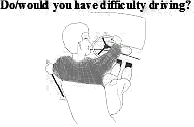
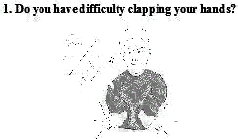
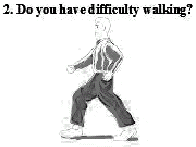

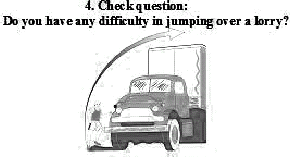
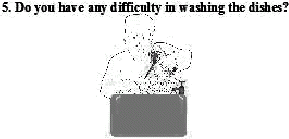
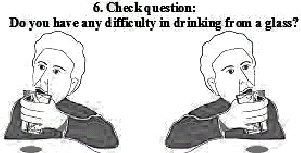
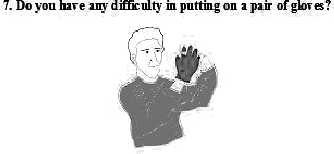
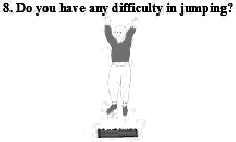
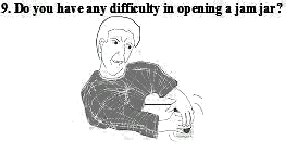

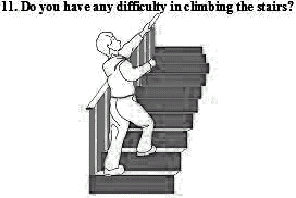
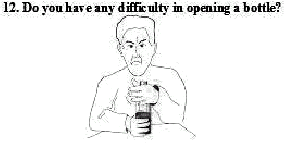
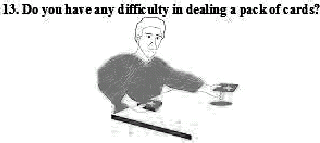
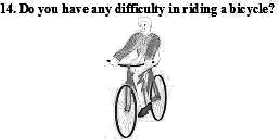
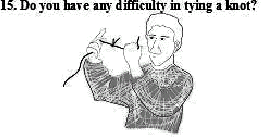
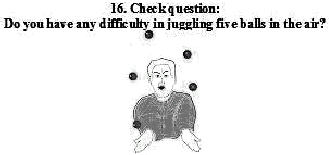
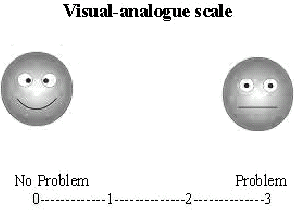 For questions 6 and 10, the “left” or “right” version of the drawing was presented according to the side of motor disorder.
For questions 6 and 10, the “left” or “right” version of the drawing was presented according to the side of motor disorder.
Expected ratings for check questions 4 and 16 are 2 or 3; expected ratings for check questions 5 and 7 are 0 or 1.
